Managerial Accounting Report: Standard and Target Costing Analysis
VerifiedAdded on 2022/08/23
|14
|3722
|19
Report
AI Summary
This report undertakes a comparative analysis of standard and target costing methods within managerial accounting, exploring their application in modern businesses. It begins with an introduction, followed by an analysis of the effectiveness of standard and target costing as measures of planning and control. The report then examines the usage of standard costing in a real-life company, drawing on journal articles to illustrate practical implementation. Key features and limitations of both methods are discussed, including the advantages of standard costing in terms of flexibility and its limitations regarding overhead allocation and qualitative aspects. Target costing is presented as a modern cost management technique. The report concludes with recommendations and a comparative analysis, providing a comprehensive overview of both costing systems and their relevance in contemporary business environments. The report also provides the real-life usage of standard costing in a company, highlighting its benefits and drawbacks.
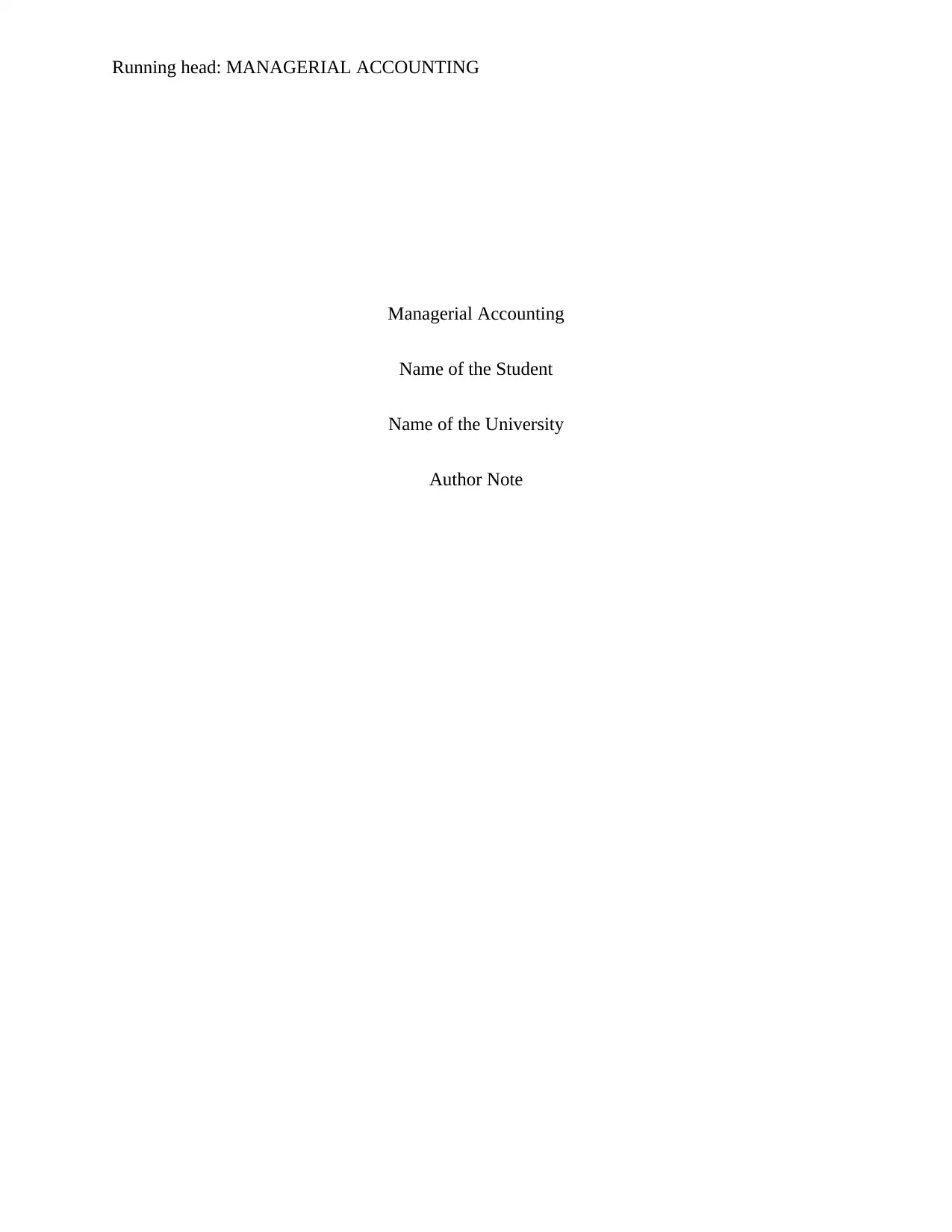
Running head: MANAGERIAL ACCOUNTING
Managerial Accounting
Name of the Student
Name of the University
Author Note
Managerial Accounting
Name of the Student
Name of the University
Author Note
Paraphrase This Document
Need a fresh take? Get an instant paraphrase of this document with our AI Paraphraser
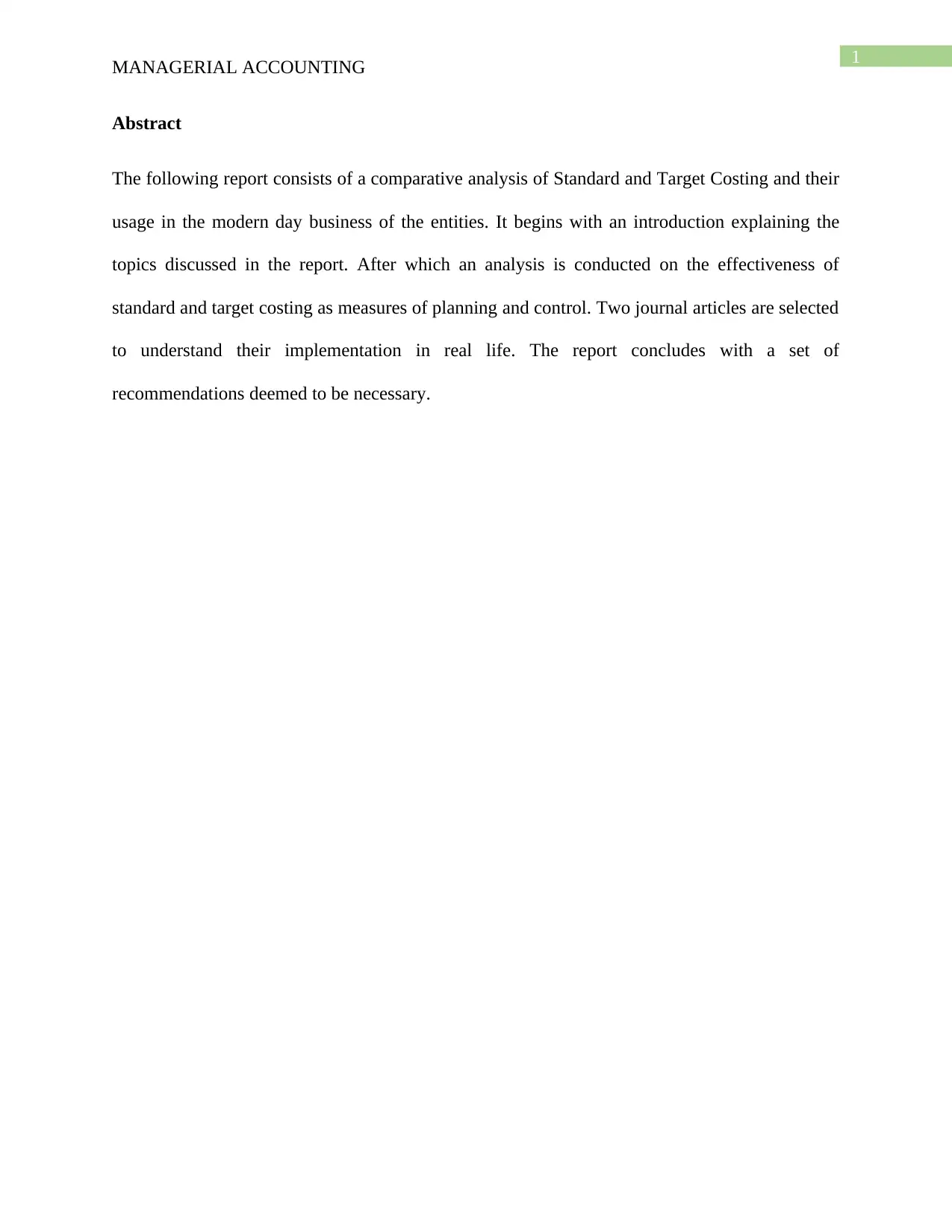
1
MANAGERIAL ACCOUNTING
Abstract
The following report consists of a comparative analysis of Standard and Target Costing and their
usage in the modern day business of the entities. It begins with an introduction explaining the
topics discussed in the report. After which an analysis is conducted on the effectiveness of
standard and target costing as measures of planning and control. Two journal articles are selected
to understand their implementation in real life. The report concludes with a set of
recommendations deemed to be necessary.
MANAGERIAL ACCOUNTING
Abstract
The following report consists of a comparative analysis of Standard and Target Costing and their
usage in the modern day business of the entities. It begins with an introduction explaining the
topics discussed in the report. After which an analysis is conducted on the effectiveness of
standard and target costing as measures of planning and control. Two journal articles are selected
to understand their implementation in real life. The report concludes with a set of
recommendations deemed to be necessary.
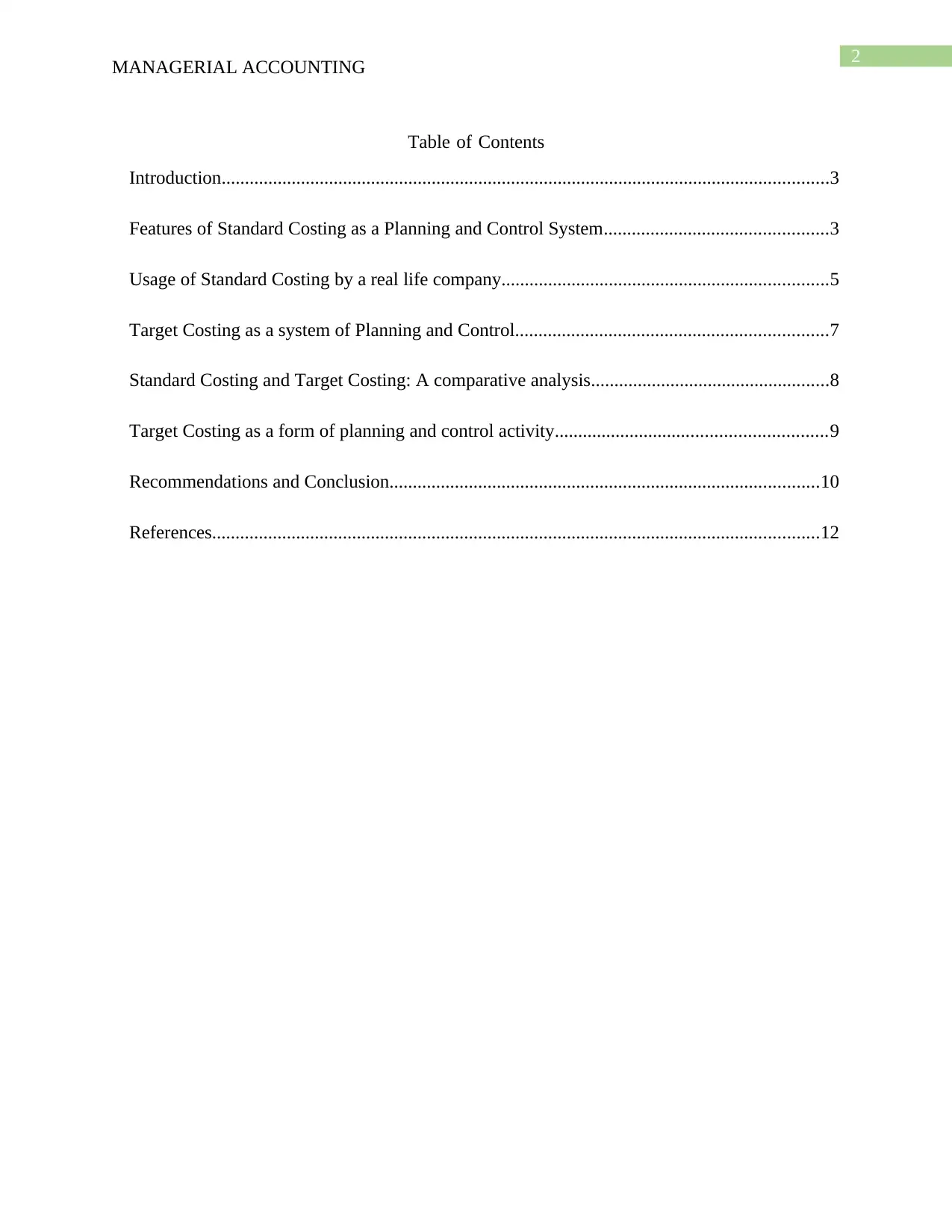
2
MANAGERIAL ACCOUNTING
Table of Contents
Introduction..................................................................................................................................3
Features of Standard Costing as a Planning and Control System................................................3
Usage of Standard Costing by a real life company......................................................................5
Target Costing as a system of Planning and Control...................................................................7
Standard Costing and Target Costing: A comparative analysis...................................................8
Target Costing as a form of planning and control activity..........................................................9
Recommendations and Conclusion............................................................................................10
References..................................................................................................................................12
MANAGERIAL ACCOUNTING
Table of Contents
Introduction..................................................................................................................................3
Features of Standard Costing as a Planning and Control System................................................3
Usage of Standard Costing by a real life company......................................................................5
Target Costing as a system of Planning and Control...................................................................7
Standard Costing and Target Costing: A comparative analysis...................................................8
Target Costing as a form of planning and control activity..........................................................9
Recommendations and Conclusion............................................................................................10
References..................................................................................................................................12
You're viewing a preview
Unlock full access by subscribing today!
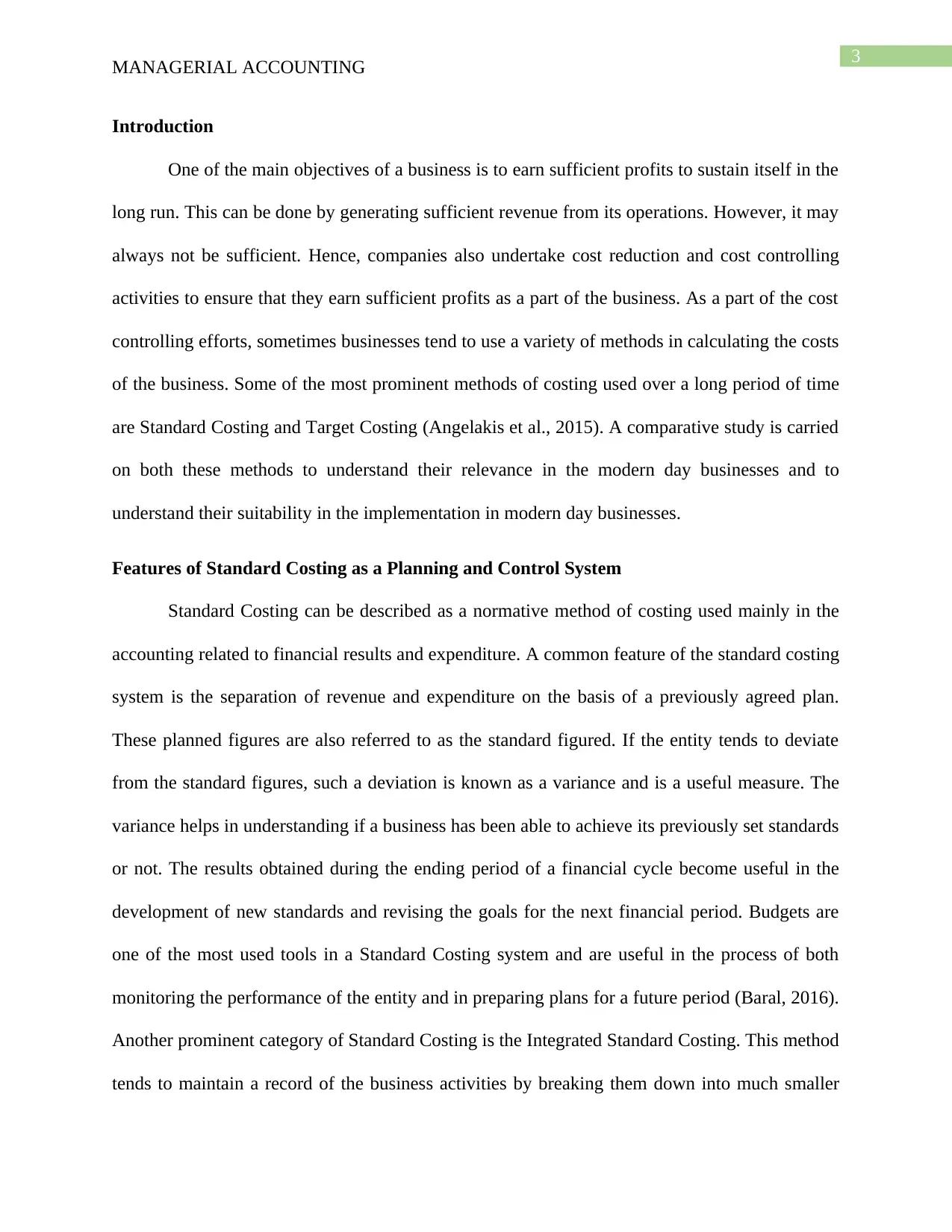
3
MANAGERIAL ACCOUNTING
Introduction
One of the main objectives of a business is to earn sufficient profits to sustain itself in the
long run. This can be done by generating sufficient revenue from its operations. However, it may
always not be sufficient. Hence, companies also undertake cost reduction and cost controlling
activities to ensure that they earn sufficient profits as a part of the business. As a part of the cost
controlling efforts, sometimes businesses tend to use a variety of methods in calculating the costs
of the business. Some of the most prominent methods of costing used over a long period of time
are Standard Costing and Target Costing (Angelakis et al., 2015). A comparative study is carried
on both these methods to understand their relevance in the modern day businesses and to
understand their suitability in the implementation in modern day businesses.
Features of Standard Costing as a Planning and Control System
Standard Costing can be described as a normative method of costing used mainly in the
accounting related to financial results and expenditure. A common feature of the standard costing
system is the separation of revenue and expenditure on the basis of a previously agreed plan.
These planned figures are also referred to as the standard figured. If the entity tends to deviate
from the standard figures, such a deviation is known as a variance and is a useful measure. The
variance helps in understanding if a business has been able to achieve its previously set standards
or not. The results obtained during the ending period of a financial cycle become useful in the
development of new standards and revising the goals for the next financial period. Budgets are
one of the most used tools in a Standard Costing system and are useful in the process of both
monitoring the performance of the entity and in preparing plans for a future period (Baral, 2016).
Another prominent category of Standard Costing is the Integrated Standard Costing. This method
tends to maintain a record of the business activities by breaking them down into much smaller
MANAGERIAL ACCOUNTING
Introduction
One of the main objectives of a business is to earn sufficient profits to sustain itself in the
long run. This can be done by generating sufficient revenue from its operations. However, it may
always not be sufficient. Hence, companies also undertake cost reduction and cost controlling
activities to ensure that they earn sufficient profits as a part of the business. As a part of the cost
controlling efforts, sometimes businesses tend to use a variety of methods in calculating the costs
of the business. Some of the most prominent methods of costing used over a long period of time
are Standard Costing and Target Costing (Angelakis et al., 2015). A comparative study is carried
on both these methods to understand their relevance in the modern day businesses and to
understand their suitability in the implementation in modern day businesses.
Features of Standard Costing as a Planning and Control System
Standard Costing can be described as a normative method of costing used mainly in the
accounting related to financial results and expenditure. A common feature of the standard costing
system is the separation of revenue and expenditure on the basis of a previously agreed plan.
These planned figures are also referred to as the standard figured. If the entity tends to deviate
from the standard figures, such a deviation is known as a variance and is a useful measure. The
variance helps in understanding if a business has been able to achieve its previously set standards
or not. The results obtained during the ending period of a financial cycle become useful in the
development of new standards and revising the goals for the next financial period. Budgets are
one of the most used tools in a Standard Costing system and are useful in the process of both
monitoring the performance of the entity and in preparing plans for a future period (Baral, 2016).
Another prominent category of Standard Costing is the Integrated Standard Costing. This method
tends to maintain a record of the business activities by breaking them down into much smaller
Paraphrase This Document
Need a fresh take? Get an instant paraphrase of this document with our AI Paraphraser
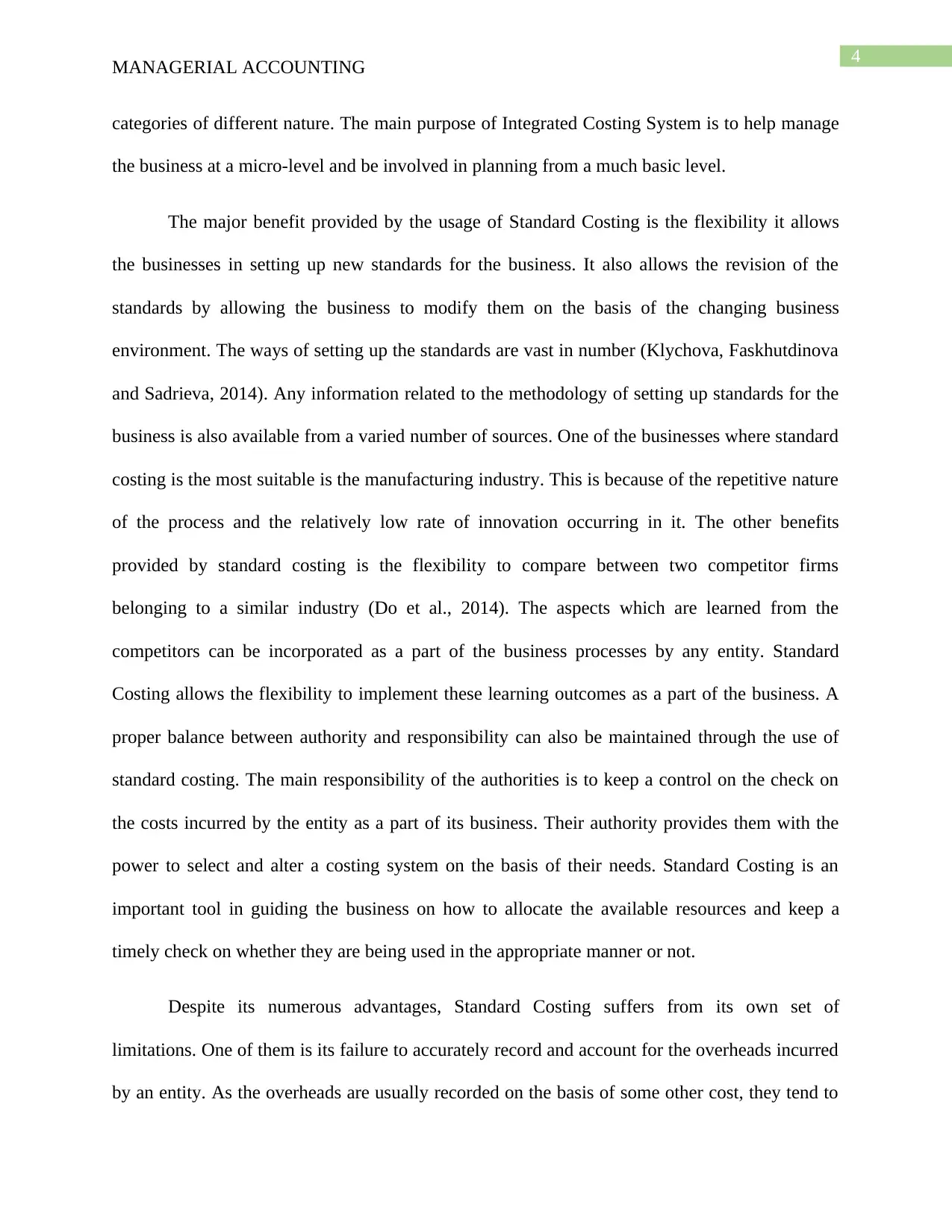
4
MANAGERIAL ACCOUNTING
categories of different nature. The main purpose of Integrated Costing System is to help manage
the business at a micro-level and be involved in planning from a much basic level.
The major benefit provided by the usage of Standard Costing is the flexibility it allows
the businesses in setting up new standards for the business. It also allows the revision of the
standards by allowing the business to modify them on the basis of the changing business
environment. The ways of setting up the standards are vast in number (Klychova, Faskhutdinova
and Sadrieva, 2014). Any information related to the methodology of setting up standards for the
business is also available from a varied number of sources. One of the businesses where standard
costing is the most suitable is the manufacturing industry. This is because of the repetitive nature
of the process and the relatively low rate of innovation occurring in it. The other benefits
provided by standard costing is the flexibility to compare between two competitor firms
belonging to a similar industry (Do et al., 2014). The aspects which are learned from the
competitors can be incorporated as a part of the business processes by any entity. Standard
Costing allows the flexibility to implement these learning outcomes as a part of the business. A
proper balance between authority and responsibility can also be maintained through the use of
standard costing. The main responsibility of the authorities is to keep a control on the check on
the costs incurred by the entity as a part of its business. Their authority provides them with the
power to select and alter a costing system on the basis of their needs. Standard Costing is an
important tool in guiding the business on how to allocate the available resources and keep a
timely check on whether they are being used in the appropriate manner or not.
Despite its numerous advantages, Standard Costing suffers from its own set of
limitations. One of them is its failure to accurately record and account for the overheads incurred
by an entity. As the overheads are usually recorded on the basis of some other cost, they tend to
MANAGERIAL ACCOUNTING
categories of different nature. The main purpose of Integrated Costing System is to help manage
the business at a micro-level and be involved in planning from a much basic level.
The major benefit provided by the usage of Standard Costing is the flexibility it allows
the businesses in setting up new standards for the business. It also allows the revision of the
standards by allowing the business to modify them on the basis of the changing business
environment. The ways of setting up the standards are vast in number (Klychova, Faskhutdinova
and Sadrieva, 2014). Any information related to the methodology of setting up standards for the
business is also available from a varied number of sources. One of the businesses where standard
costing is the most suitable is the manufacturing industry. This is because of the repetitive nature
of the process and the relatively low rate of innovation occurring in it. The other benefits
provided by standard costing is the flexibility to compare between two competitor firms
belonging to a similar industry (Do et al., 2014). The aspects which are learned from the
competitors can be incorporated as a part of the business processes by any entity. Standard
Costing allows the flexibility to implement these learning outcomes as a part of the business. A
proper balance between authority and responsibility can also be maintained through the use of
standard costing. The main responsibility of the authorities is to keep a control on the check on
the costs incurred by the entity as a part of its business. Their authority provides them with the
power to select and alter a costing system on the basis of their needs. Standard Costing is an
important tool in guiding the business on how to allocate the available resources and keep a
timely check on whether they are being used in the appropriate manner or not.
Despite its numerous advantages, Standard Costing suffers from its own set of
limitations. One of them is its failure to accurately record and account for the overheads incurred
by an entity. As the overheads are usually recorded on the basis of some other cost, they tend to

5
MANAGERIAL ACCOUNTING
become lower than they are and the final results turn out to be misleading. Standard Costing
generally tend to focus only the targets which can be expressed in numerical terms. It is usually
not concerned about qualitative aspects like the functionality and the efficiency of the products
produced. Their prominence cannot be understated in the modern day business entities which
give a lot of value to the opinion of the consumers and their preferences. Standard Costing is
extremely efficient in terms of allocating direct costs such as Direct Material and Direct Labour.
But its ineffectiveness in terms of allocating the indirect costs results in it being limited to only a
particular set of industries. However, some researchers suggest that using standard costing in
tandem with other widely accepted forms of costing like ABC and Absorption costing resulted in
improving the effectiveness of the results produced by Standard Costing (Tsifora and
Chatzoglou, 2016).
Usage of Standard Costing by a real life company
In order to understand the relevance of a traditional method of costing like Standard
Costing in the modern day business, a journal article based on the usage of Standard Costing in a
modern day business was selected (Iafa.ie. 2020). The article’s main purpose was to conduct a
study on the usage of standard costing in an Irish manufacturing company. In order to do so, it
also included the aspect of the impact of change management on a modern day entity. It mainly
focussed on the manner in which a traditional costing method like standard costing can be deeply
embedded in an organisation while also being able to encompass the changes occurring in the
business environment and the outside world. However, one aspect which was highlighted as a
part of the findings is the nature of the industry selected. The company selected for the case
study, Engineering Limited was involved in conducting business in manufacturing electrical
products. The nature of the business is such that it has an extremely stable costing structure and
MANAGERIAL ACCOUNTING
become lower than they are and the final results turn out to be misleading. Standard Costing
generally tend to focus only the targets which can be expressed in numerical terms. It is usually
not concerned about qualitative aspects like the functionality and the efficiency of the products
produced. Their prominence cannot be understated in the modern day business entities which
give a lot of value to the opinion of the consumers and their preferences. Standard Costing is
extremely efficient in terms of allocating direct costs such as Direct Material and Direct Labour.
But its ineffectiveness in terms of allocating the indirect costs results in it being limited to only a
particular set of industries. However, some researchers suggest that using standard costing in
tandem with other widely accepted forms of costing like ABC and Absorption costing resulted in
improving the effectiveness of the results produced by Standard Costing (Tsifora and
Chatzoglou, 2016).
Usage of Standard Costing by a real life company
In order to understand the relevance of a traditional method of costing like Standard
Costing in the modern day business, a journal article based on the usage of Standard Costing in a
modern day business was selected (Iafa.ie. 2020). The article’s main purpose was to conduct a
study on the usage of standard costing in an Irish manufacturing company. In order to do so, it
also included the aspect of the impact of change management on a modern day entity. It mainly
focussed on the manner in which a traditional costing method like standard costing can be deeply
embedded in an organisation while also being able to encompass the changes occurring in the
business environment and the outside world. However, one aspect which was highlighted as a
part of the findings is the nature of the industry selected. The company selected for the case
study, Engineering Limited was involved in conducting business in manufacturing electrical
products. The nature of the business is such that it has an extremely stable costing structure and
You're viewing a preview
Unlock full access by subscribing today!
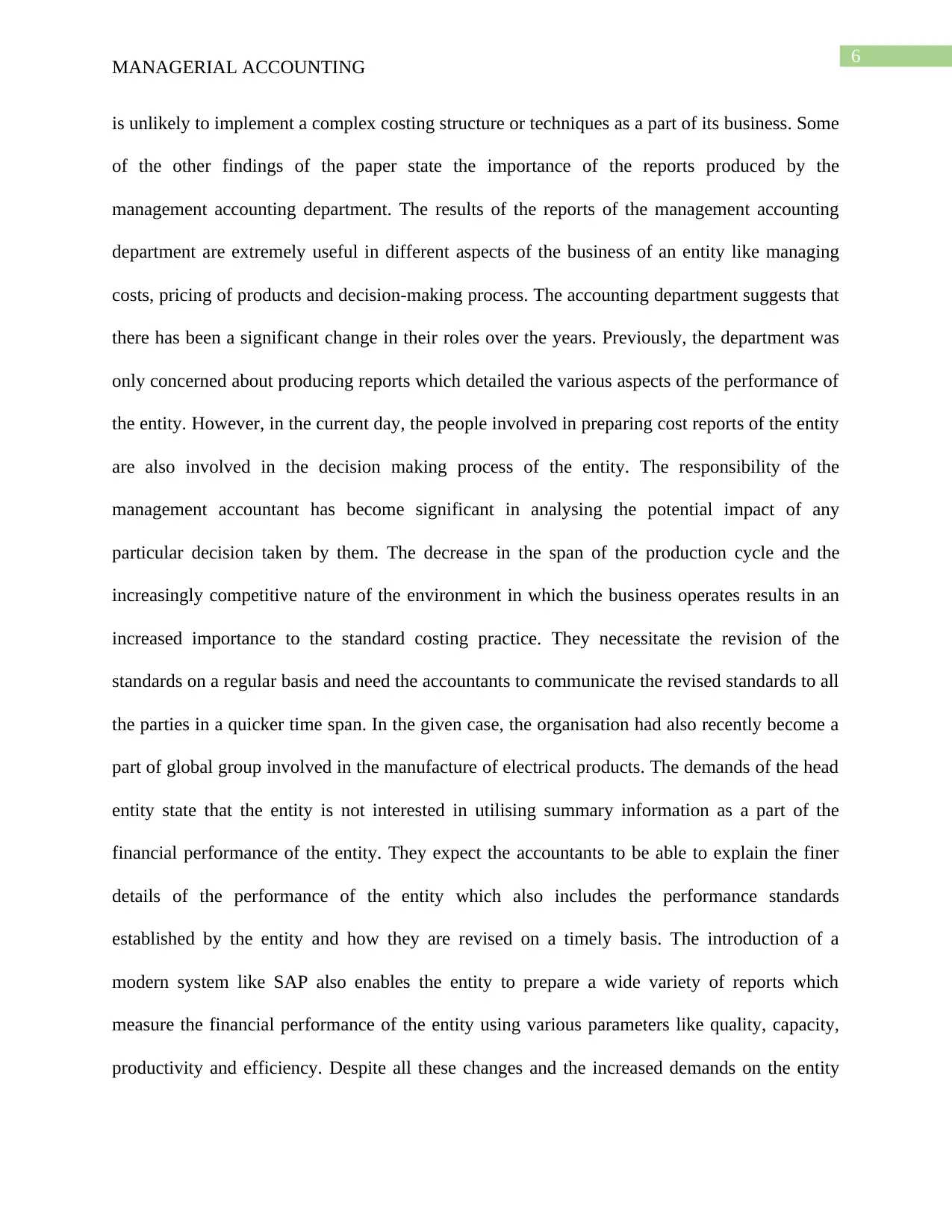
6
MANAGERIAL ACCOUNTING
is unlikely to implement a complex costing structure or techniques as a part of its business. Some
of the other findings of the paper state the importance of the reports produced by the
management accounting department. The results of the reports of the management accounting
department are extremely useful in different aspects of the business of an entity like managing
costs, pricing of products and decision-making process. The accounting department suggests that
there has been a significant change in their roles over the years. Previously, the department was
only concerned about producing reports which detailed the various aspects of the performance of
the entity. However, in the current day, the people involved in preparing cost reports of the entity
are also involved in the decision making process of the entity. The responsibility of the
management accountant has become significant in analysing the potential impact of any
particular decision taken by them. The decrease in the span of the production cycle and the
increasingly competitive nature of the environment in which the business operates results in an
increased importance to the standard costing practice. They necessitate the revision of the
standards on a regular basis and need the accountants to communicate the revised standards to all
the parties in a quicker time span. In the given case, the organisation had also recently become a
part of global group involved in the manufacture of electrical products. The demands of the head
entity state that the entity is not interested in utilising summary information as a part of the
financial performance of the entity. They expect the accountants to be able to explain the finer
details of the performance of the entity which also includes the performance standards
established by the entity and how they are revised on a timely basis. The introduction of a
modern system like SAP also enables the entity to prepare a wide variety of reports which
measure the financial performance of the entity using various parameters like quality, capacity,
productivity and efficiency. Despite all these changes and the increased demands on the entity
MANAGERIAL ACCOUNTING
is unlikely to implement a complex costing structure or techniques as a part of its business. Some
of the other findings of the paper state the importance of the reports produced by the
management accounting department. The results of the reports of the management accounting
department are extremely useful in different aspects of the business of an entity like managing
costs, pricing of products and decision-making process. The accounting department suggests that
there has been a significant change in their roles over the years. Previously, the department was
only concerned about producing reports which detailed the various aspects of the performance of
the entity. However, in the current day, the people involved in preparing cost reports of the entity
are also involved in the decision making process of the entity. The responsibility of the
management accountant has become significant in analysing the potential impact of any
particular decision taken by them. The decrease in the span of the production cycle and the
increasingly competitive nature of the environment in which the business operates results in an
increased importance to the standard costing practice. They necessitate the revision of the
standards on a regular basis and need the accountants to communicate the revised standards to all
the parties in a quicker time span. In the given case, the organisation had also recently become a
part of global group involved in the manufacture of electrical products. The demands of the head
entity state that the entity is not interested in utilising summary information as a part of the
financial performance of the entity. They expect the accountants to be able to explain the finer
details of the performance of the entity which also includes the performance standards
established by the entity and how they are revised on a timely basis. The introduction of a
modern system like SAP also enables the entity to prepare a wide variety of reports which
measure the financial performance of the entity using various parameters like quality, capacity,
productivity and efficiency. Despite all these changes and the increased demands on the entity
Paraphrase This Document
Need a fresh take? Get an instant paraphrase of this document with our AI Paraphraser
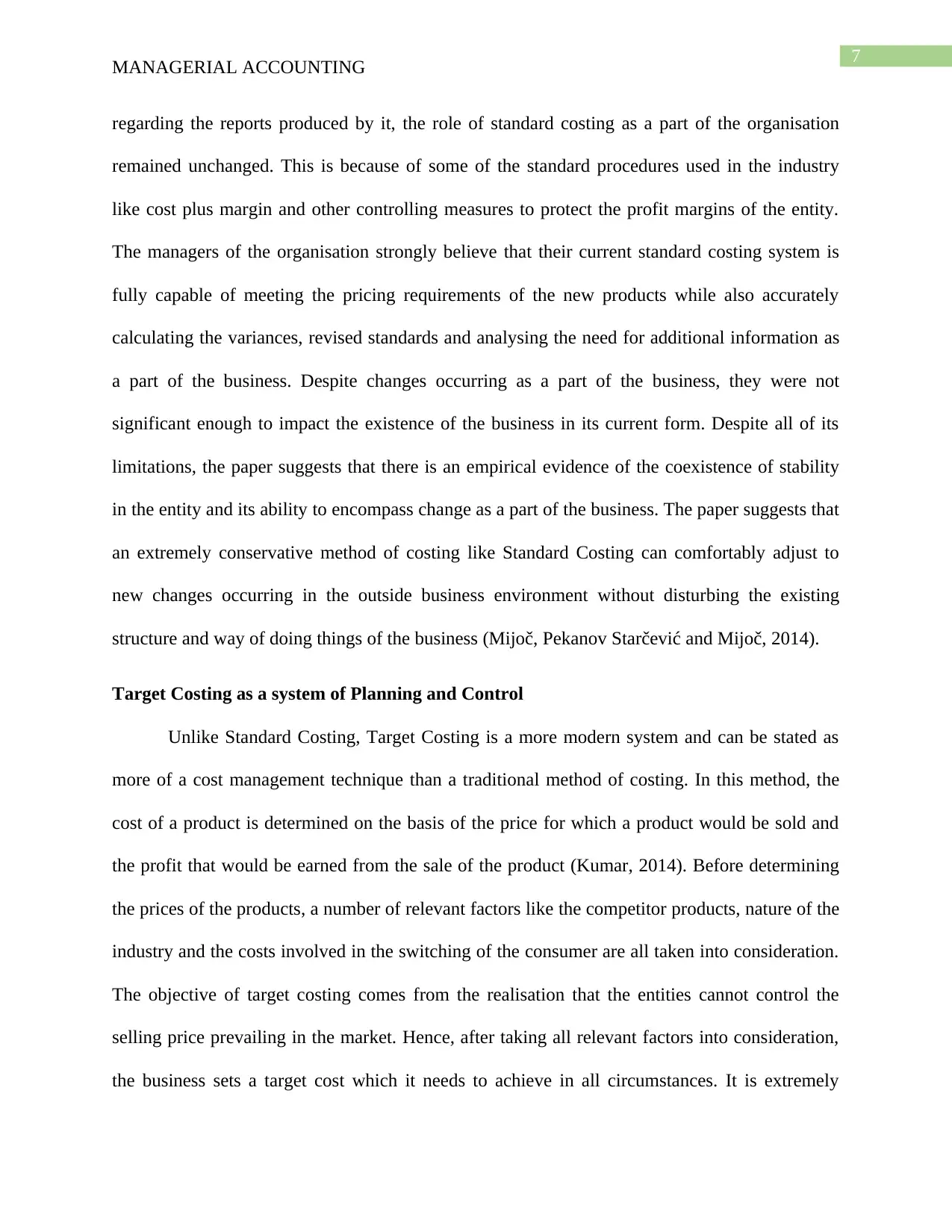
7
MANAGERIAL ACCOUNTING
regarding the reports produced by it, the role of standard costing as a part of the organisation
remained unchanged. This is because of some of the standard procedures used in the industry
like cost plus margin and other controlling measures to protect the profit margins of the entity.
The managers of the organisation strongly believe that their current standard costing system is
fully capable of meeting the pricing requirements of the new products while also accurately
calculating the variances, revised standards and analysing the need for additional information as
a part of the business. Despite changes occurring as a part of the business, they were not
significant enough to impact the existence of the business in its current form. Despite all of its
limitations, the paper suggests that there is an empirical evidence of the coexistence of stability
in the entity and its ability to encompass change as a part of the business. The paper suggests that
an extremely conservative method of costing like Standard Costing can comfortably adjust to
new changes occurring in the outside business environment without disturbing the existing
structure and way of doing things of the business (Mijoč, Pekanov Starčević and Mijoč, 2014).
Target Costing as a system of Planning and Control
Unlike Standard Costing, Target Costing is a more modern system and can be stated as
more of a cost management technique than a traditional method of costing. In this method, the
cost of a product is determined on the basis of the price for which a product would be sold and
the profit that would be earned from the sale of the product (Kumar, 2014). Before determining
the prices of the products, a number of relevant factors like the competitor products, nature of the
industry and the costs involved in the switching of the consumer are all taken into consideration.
The objective of target costing comes from the realisation that the entities cannot control the
selling price prevailing in the market. Hence, after taking all relevant factors into consideration,
the business sets a target cost which it needs to achieve in all circumstances. It is extremely
MANAGERIAL ACCOUNTING
regarding the reports produced by it, the role of standard costing as a part of the organisation
remained unchanged. This is because of some of the standard procedures used in the industry
like cost plus margin and other controlling measures to protect the profit margins of the entity.
The managers of the organisation strongly believe that their current standard costing system is
fully capable of meeting the pricing requirements of the new products while also accurately
calculating the variances, revised standards and analysing the need for additional information as
a part of the business. Despite changes occurring as a part of the business, they were not
significant enough to impact the existence of the business in its current form. Despite all of its
limitations, the paper suggests that there is an empirical evidence of the coexistence of stability
in the entity and its ability to encompass change as a part of the business. The paper suggests that
an extremely conservative method of costing like Standard Costing can comfortably adjust to
new changes occurring in the outside business environment without disturbing the existing
structure and way of doing things of the business (Mijoč, Pekanov Starčević and Mijoč, 2014).
Target Costing as a system of Planning and Control
Unlike Standard Costing, Target Costing is a more modern system and can be stated as
more of a cost management technique than a traditional method of costing. In this method, the
cost of a product is determined on the basis of the price for which a product would be sold and
the profit that would be earned from the sale of the product (Kumar, 2014). Before determining
the prices of the products, a number of relevant factors like the competitor products, nature of the
industry and the costs involved in the switching of the consumer are all taken into consideration.
The objective of target costing comes from the realisation that the entities cannot control the
selling price prevailing in the market. Hence, after taking all relevant factors into consideration,
the business sets a target cost which it needs to achieve in all circumstances. It is extremely
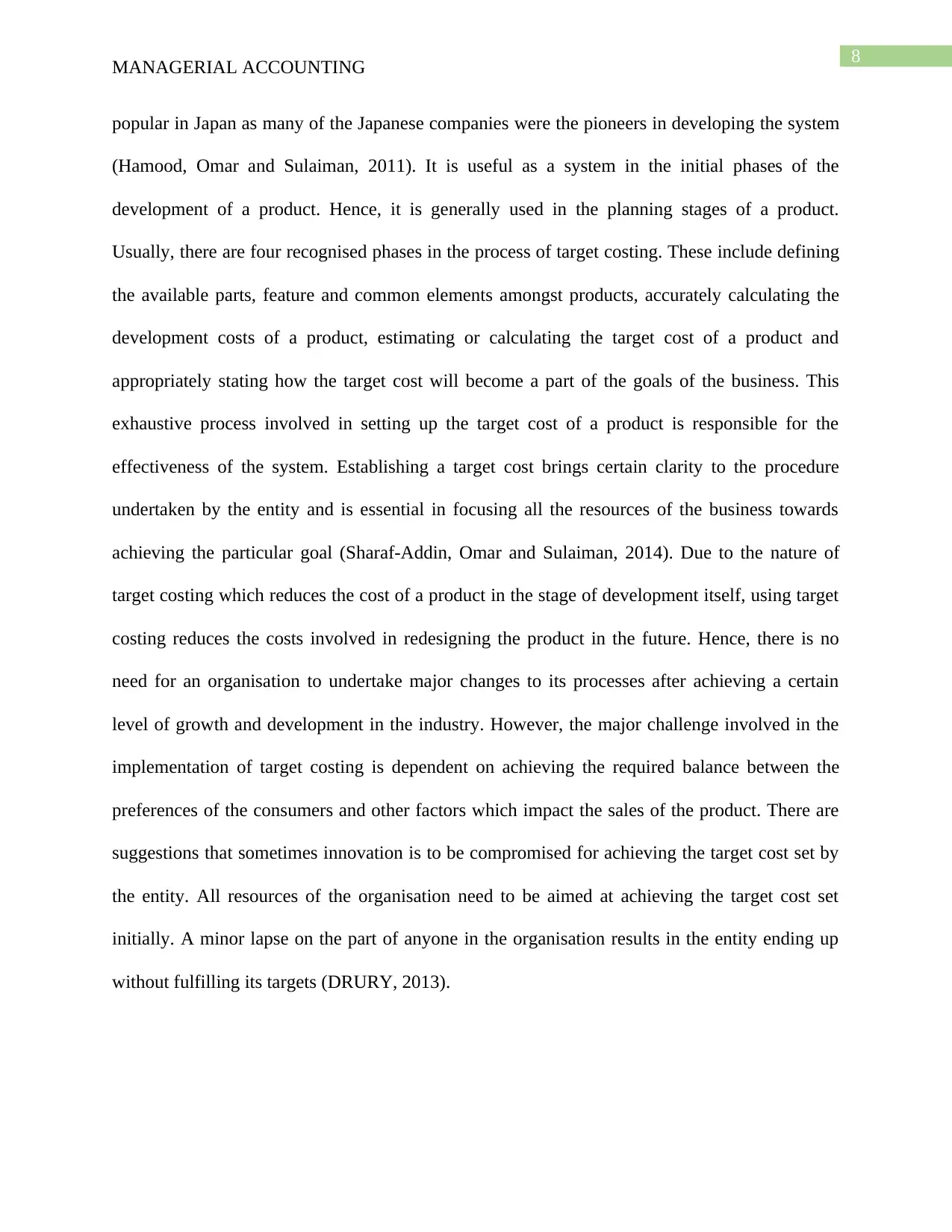
8
MANAGERIAL ACCOUNTING
popular in Japan as many of the Japanese companies were the pioneers in developing the system
(Hamood, Omar and Sulaiman, 2011). It is useful as a system in the initial phases of the
development of a product. Hence, it is generally used in the planning stages of a product.
Usually, there are four recognised phases in the process of target costing. These include defining
the available parts, feature and common elements amongst products, accurately calculating the
development costs of a product, estimating or calculating the target cost of a product and
appropriately stating how the target cost will become a part of the goals of the business. This
exhaustive process involved in setting up the target cost of a product is responsible for the
effectiveness of the system. Establishing a target cost brings certain clarity to the procedure
undertaken by the entity and is essential in focusing all the resources of the business towards
achieving the particular goal (Sharaf-Addin, Omar and Sulaiman, 2014). Due to the nature of
target costing which reduces the cost of a product in the stage of development itself, using target
costing reduces the costs involved in redesigning the product in the future. Hence, there is no
need for an organisation to undertake major changes to its processes after achieving a certain
level of growth and development in the industry. However, the major challenge involved in the
implementation of target costing is dependent on achieving the required balance between the
preferences of the consumers and other factors which impact the sales of the product. There are
suggestions that sometimes innovation is to be compromised for achieving the target cost set by
the entity. All resources of the organisation need to be aimed at achieving the target cost set
initially. A minor lapse on the part of anyone in the organisation results in the entity ending up
without fulfilling its targets (DRURY, 2013).
MANAGERIAL ACCOUNTING
popular in Japan as many of the Japanese companies were the pioneers in developing the system
(Hamood, Omar and Sulaiman, 2011). It is useful as a system in the initial phases of the
development of a product. Hence, it is generally used in the planning stages of a product.
Usually, there are four recognised phases in the process of target costing. These include defining
the available parts, feature and common elements amongst products, accurately calculating the
development costs of a product, estimating or calculating the target cost of a product and
appropriately stating how the target cost will become a part of the goals of the business. This
exhaustive process involved in setting up the target cost of a product is responsible for the
effectiveness of the system. Establishing a target cost brings certain clarity to the procedure
undertaken by the entity and is essential in focusing all the resources of the business towards
achieving the particular goal (Sharaf-Addin, Omar and Sulaiman, 2014). Due to the nature of
target costing which reduces the cost of a product in the stage of development itself, using target
costing reduces the costs involved in redesigning the product in the future. Hence, there is no
need for an organisation to undertake major changes to its processes after achieving a certain
level of growth and development in the industry. However, the major challenge involved in the
implementation of target costing is dependent on achieving the required balance between the
preferences of the consumers and other factors which impact the sales of the product. There are
suggestions that sometimes innovation is to be compromised for achieving the target cost set by
the entity. All resources of the organisation need to be aimed at achieving the target cost set
initially. A minor lapse on the part of anyone in the organisation results in the entity ending up
without fulfilling its targets (DRURY, 2013).
You're viewing a preview
Unlock full access by subscribing today!
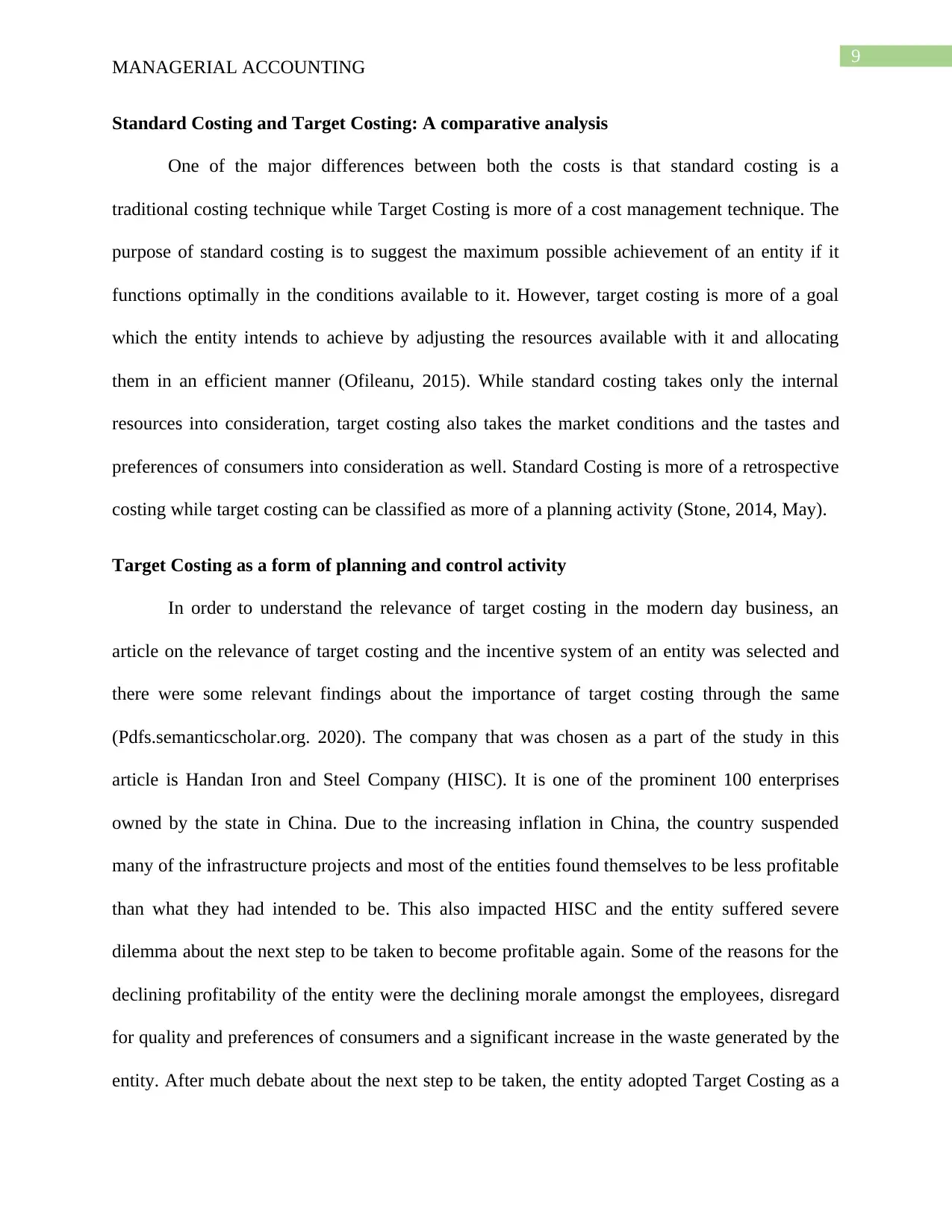
9
MANAGERIAL ACCOUNTING
Standard Costing and Target Costing: A comparative analysis
One of the major differences between both the costs is that standard costing is a
traditional costing technique while Target Costing is more of a cost management technique. The
purpose of standard costing is to suggest the maximum possible achievement of an entity if it
functions optimally in the conditions available to it. However, target costing is more of a goal
which the entity intends to achieve by adjusting the resources available with it and allocating
them in an efficient manner (Ofileanu, 2015). While standard costing takes only the internal
resources into consideration, target costing also takes the market conditions and the tastes and
preferences of consumers into consideration as well. Standard Costing is more of a retrospective
costing while target costing can be classified as more of a planning activity (Stone, 2014, May).
Target Costing as a form of planning and control activity
In order to understand the relevance of target costing in the modern day business, an
article on the relevance of target costing and the incentive system of an entity was selected and
there were some relevant findings about the importance of target costing through the same
(Pdfs.semanticscholar.org. 2020). The company that was chosen as a part of the study in this
article is Handan Iron and Steel Company (HISC). It is one of the prominent 100 enterprises
owned by the state in China. Due to the increasing inflation in China, the country suspended
many of the infrastructure projects and most of the entities found themselves to be less profitable
than what they had intended to be. This also impacted HISC and the entity suffered severe
dilemma about the next step to be taken to become profitable again. Some of the reasons for the
declining profitability of the entity were the declining morale amongst the employees, disregard
for quality and preferences of consumers and a significant increase in the waste generated by the
entity. After much debate about the next step to be taken, the entity adopted Target Costing as a
MANAGERIAL ACCOUNTING
Standard Costing and Target Costing: A comparative analysis
One of the major differences between both the costs is that standard costing is a
traditional costing technique while Target Costing is more of a cost management technique. The
purpose of standard costing is to suggest the maximum possible achievement of an entity if it
functions optimally in the conditions available to it. However, target costing is more of a goal
which the entity intends to achieve by adjusting the resources available with it and allocating
them in an efficient manner (Ofileanu, 2015). While standard costing takes only the internal
resources into consideration, target costing also takes the market conditions and the tastes and
preferences of consumers into consideration as well. Standard Costing is more of a retrospective
costing while target costing can be classified as more of a planning activity (Stone, 2014, May).
Target Costing as a form of planning and control activity
In order to understand the relevance of target costing in the modern day business, an
article on the relevance of target costing and the incentive system of an entity was selected and
there were some relevant findings about the importance of target costing through the same
(Pdfs.semanticscholar.org. 2020). The company that was chosen as a part of the study in this
article is Handan Iron and Steel Company (HISC). It is one of the prominent 100 enterprises
owned by the state in China. Due to the increasing inflation in China, the country suspended
many of the infrastructure projects and most of the entities found themselves to be less profitable
than what they had intended to be. This also impacted HISC and the entity suffered severe
dilemma about the next step to be taken to become profitable again. Some of the reasons for the
declining profitability of the entity were the declining morale amongst the employees, disregard
for quality and preferences of consumers and a significant increase in the waste generated by the
entity. After much debate about the next step to be taken, the entity adopted Target Costing as a
Paraphrase This Document
Need a fresh take? Get an instant paraphrase of this document with our AI Paraphraser
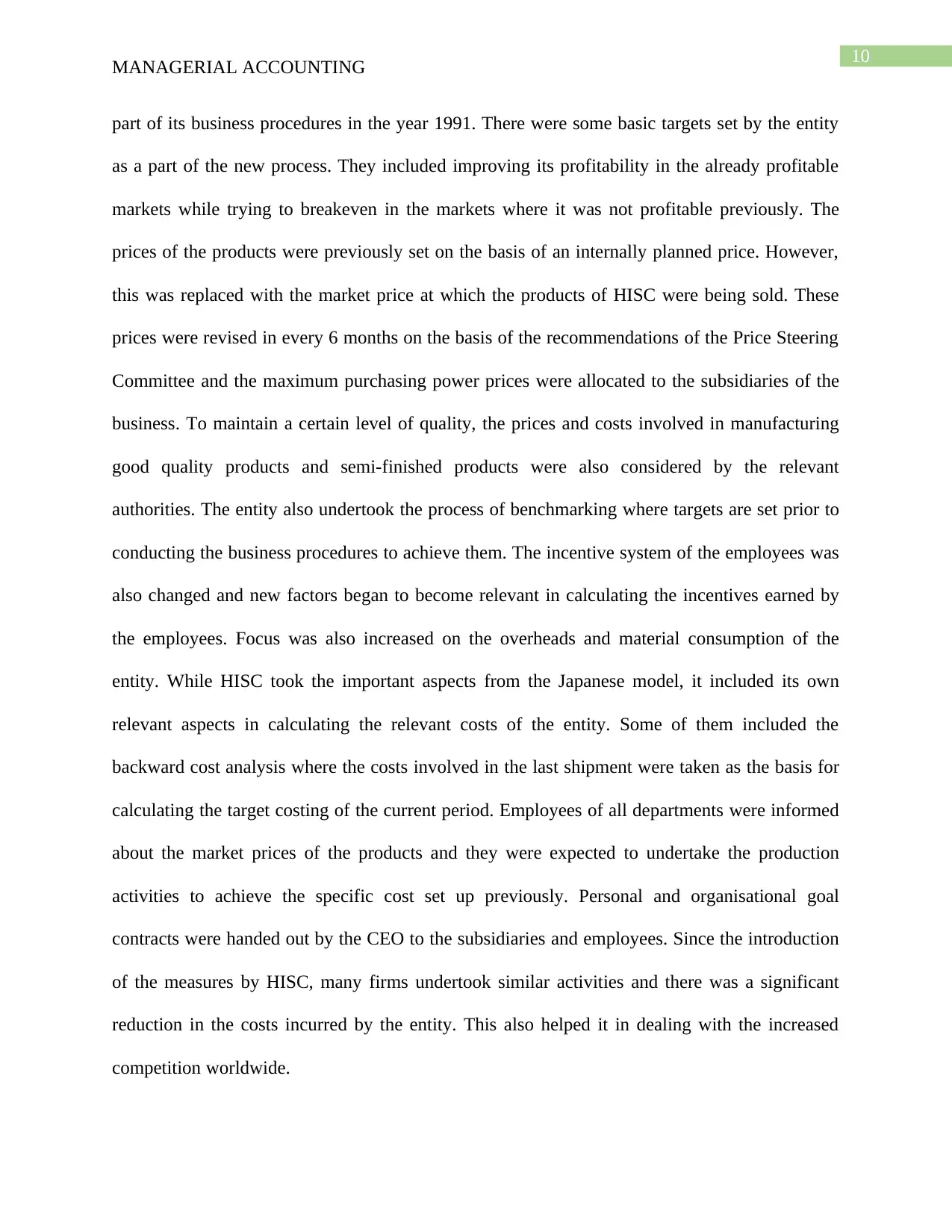
10
MANAGERIAL ACCOUNTING
part of its business procedures in the year 1991. There were some basic targets set by the entity
as a part of the new process. They included improving its profitability in the already profitable
markets while trying to breakeven in the markets where it was not profitable previously. The
prices of the products were previously set on the basis of an internally planned price. However,
this was replaced with the market price at which the products of HISC were being sold. These
prices were revised in every 6 months on the basis of the recommendations of the Price Steering
Committee and the maximum purchasing power prices were allocated to the subsidiaries of the
business. To maintain a certain level of quality, the prices and costs involved in manufacturing
good quality products and semi-finished products were also considered by the relevant
authorities. The entity also undertook the process of benchmarking where targets are set prior to
conducting the business procedures to achieve them. The incentive system of the employees was
also changed and new factors began to become relevant in calculating the incentives earned by
the employees. Focus was also increased on the overheads and material consumption of the
entity. While HISC took the important aspects from the Japanese model, it included its own
relevant aspects in calculating the relevant costs of the entity. Some of them included the
backward cost analysis where the costs involved in the last shipment were taken as the basis for
calculating the target costing of the current period. Employees of all departments were informed
about the market prices of the products and they were expected to undertake the production
activities to achieve the specific cost set up previously. Personal and organisational goal
contracts were handed out by the CEO to the subsidiaries and employees. Since the introduction
of the measures by HISC, many firms undertook similar activities and there was a significant
reduction in the costs incurred by the entity. This also helped it in dealing with the increased
competition worldwide.
MANAGERIAL ACCOUNTING
part of its business procedures in the year 1991. There were some basic targets set by the entity
as a part of the new process. They included improving its profitability in the already profitable
markets while trying to breakeven in the markets where it was not profitable previously. The
prices of the products were previously set on the basis of an internally planned price. However,
this was replaced with the market price at which the products of HISC were being sold. These
prices were revised in every 6 months on the basis of the recommendations of the Price Steering
Committee and the maximum purchasing power prices were allocated to the subsidiaries of the
business. To maintain a certain level of quality, the prices and costs involved in manufacturing
good quality products and semi-finished products were also considered by the relevant
authorities. The entity also undertook the process of benchmarking where targets are set prior to
conducting the business procedures to achieve them. The incentive system of the employees was
also changed and new factors began to become relevant in calculating the incentives earned by
the employees. Focus was also increased on the overheads and material consumption of the
entity. While HISC took the important aspects from the Japanese model, it included its own
relevant aspects in calculating the relevant costs of the entity. Some of them included the
backward cost analysis where the costs involved in the last shipment were taken as the basis for
calculating the target costing of the current period. Employees of all departments were informed
about the market prices of the products and they were expected to undertake the production
activities to achieve the specific cost set up previously. Personal and organisational goal
contracts were handed out by the CEO to the subsidiaries and employees. Since the introduction
of the measures by HISC, many firms undertook similar activities and there was a significant
reduction in the costs incurred by the entity. This also helped it in dealing with the increased
competition worldwide.

11
MANAGERIAL ACCOUNTING
Recommendations and Conclusion
On the basis of the above discussion, a few recommendations can be made about the type
of costing system to be used by a business. In the planning phase of a product, the target costing
is an effective measure in allocating the available resources and setting up a target cost of the
product. This is because of its nature which takes most of the aspects like the market prices,
customer preferences and the estimated selling price of the entity into consideration. However,
after the commencement of the production, Standard costing should be used to understand
whether the available resources are being used to the maximum possible extent or not. These
standards should be revised in a timely manner to reflect the changing conditions in the market.
Standard Costing should also be used in combination with other forms of costing like ABC
costing to allocate overheads in a dynamic business more effectively.
MANAGERIAL ACCOUNTING
Recommendations and Conclusion
On the basis of the above discussion, a few recommendations can be made about the type
of costing system to be used by a business. In the planning phase of a product, the target costing
is an effective measure in allocating the available resources and setting up a target cost of the
product. This is because of its nature which takes most of the aspects like the market prices,
customer preferences and the estimated selling price of the entity into consideration. However,
after the commencement of the production, Standard costing should be used to understand
whether the available resources are being used to the maximum possible extent or not. These
standards should be revised in a timely manner to reflect the changing conditions in the market.
Standard Costing should also be used in combination with other forms of costing like ABC
costing to allocate overheads in a dynamic business more effectively.
You're viewing a preview
Unlock full access by subscribing today!
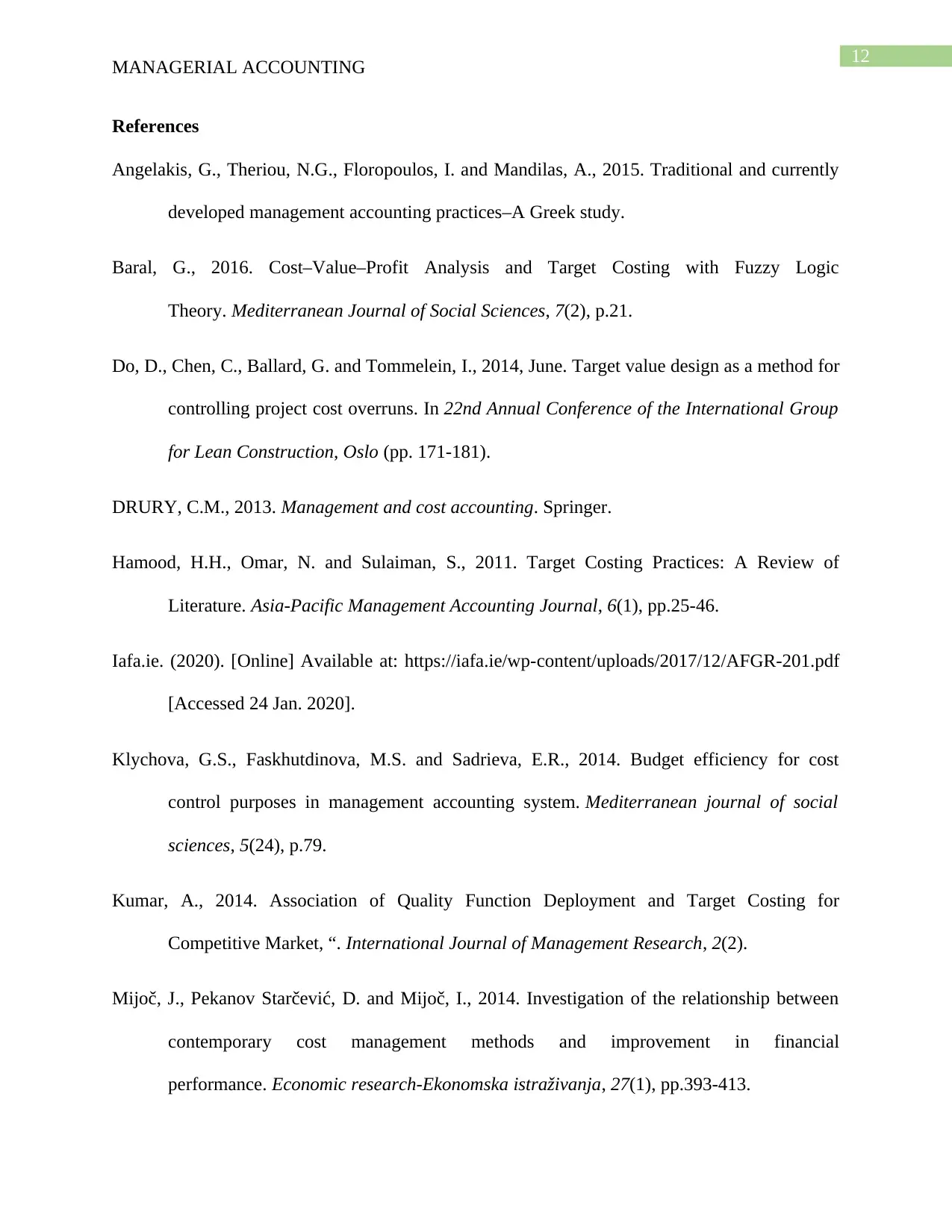
12
MANAGERIAL ACCOUNTING
References
Angelakis, G., Theriou, N.G., Floropoulos, I. and Mandilas, A., 2015. Traditional and currently
developed management accounting practices–A Greek study.
Baral, G., 2016. Cost–Value–Profit Analysis and Target Costing with Fuzzy Logic
Theory. Mediterranean Journal of Social Sciences, 7(2), p.21.
Do, D., Chen, C., Ballard, G. and Tommelein, I., 2014, June. Target value design as a method for
controlling project cost overruns. In 22nd Annual Conference of the International Group
for Lean Construction, Oslo (pp. 171-181).
DRURY, C.M., 2013. Management and cost accounting. Springer.
Hamood, H.H., Omar, N. and Sulaiman, S., 2011. Target Costing Practices: A Review of
Literature. Asia-Pacific Management Accounting Journal, 6(1), pp.25-46.
Iafa.ie. (2020). [Online] Available at: https://iafa.ie/wp-content/uploads/2017/12/AFGR-201.pdf
[Accessed 24 Jan. 2020].
Klychova, G.S., Faskhutdinova, М.S. and Sadrieva, E.R., 2014. Budget efficiency for cost
control purposes in management accounting system. Mediterranean journal of social
sciences, 5(24), p.79.
Kumar, A., 2014. Association of Quality Function Deployment and Target Costing for
Competitive Market, “. International Journal of Management Research, 2(2).
Mijoč, J., Pekanov Starčević, D. and Mijoč, I., 2014. Investigation of the relationship between
contemporary cost management methods and improvement in financial
performance. Economic research-Ekonomska istraživanja, 27(1), pp.393-413.
MANAGERIAL ACCOUNTING
References
Angelakis, G., Theriou, N.G., Floropoulos, I. and Mandilas, A., 2015. Traditional and currently
developed management accounting practices–A Greek study.
Baral, G., 2016. Cost–Value–Profit Analysis and Target Costing with Fuzzy Logic
Theory. Mediterranean Journal of Social Sciences, 7(2), p.21.
Do, D., Chen, C., Ballard, G. and Tommelein, I., 2014, June. Target value design as a method for
controlling project cost overruns. In 22nd Annual Conference of the International Group
for Lean Construction, Oslo (pp. 171-181).
DRURY, C.M., 2013. Management and cost accounting. Springer.
Hamood, H.H., Omar, N. and Sulaiman, S., 2011. Target Costing Practices: A Review of
Literature. Asia-Pacific Management Accounting Journal, 6(1), pp.25-46.
Iafa.ie. (2020). [Online] Available at: https://iafa.ie/wp-content/uploads/2017/12/AFGR-201.pdf
[Accessed 24 Jan. 2020].
Klychova, G.S., Faskhutdinova, М.S. and Sadrieva, E.R., 2014. Budget efficiency for cost
control purposes in management accounting system. Mediterranean journal of social
sciences, 5(24), p.79.
Kumar, A., 2014. Association of Quality Function Deployment and Target Costing for
Competitive Market, “. International Journal of Management Research, 2(2).
Mijoč, J., Pekanov Starčević, D. and Mijoč, I., 2014. Investigation of the relationship between
contemporary cost management methods and improvement in financial
performance. Economic research-Ekonomska istraživanja, 27(1), pp.393-413.
Paraphrase This Document
Need a fresh take? Get an instant paraphrase of this document with our AI Paraphraser
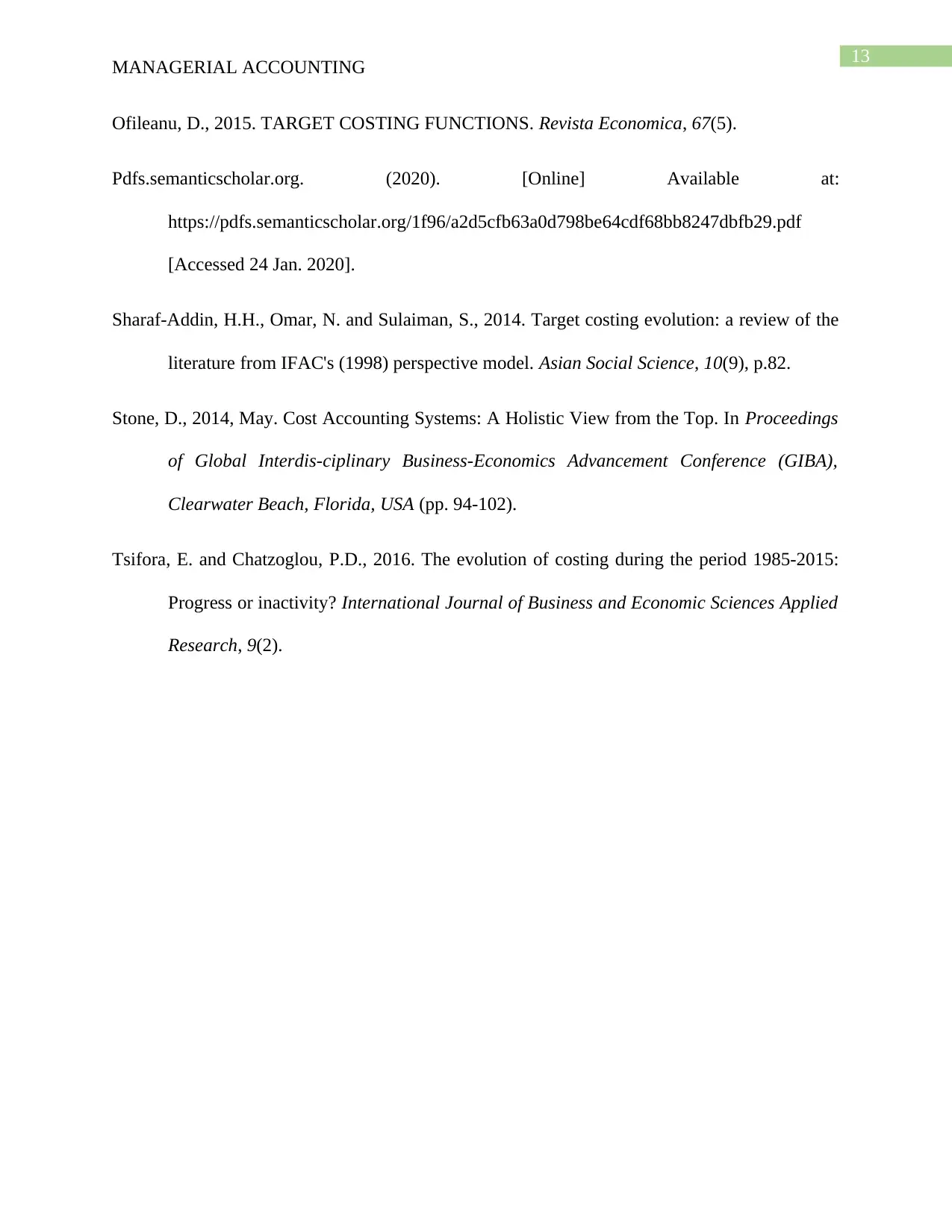
13
MANAGERIAL ACCOUNTING
Ofileanu, D., 2015. TARGET COSTING FUNCTIONS. Revista Economica, 67(5).
Pdfs.semanticscholar.org. (2020). [Online] Available at:
https://pdfs.semanticscholar.org/1f96/a2d5cfb63a0d798be64cdf68bb8247dbfb29.pdf
[Accessed 24 Jan. 2020].
Sharaf-Addin, H.H., Omar, N. and Sulaiman, S., 2014. Target costing evolution: a review of the
literature from IFAC's (1998) perspective model. Asian Social Science, 10(9), p.82.
Stone, D., 2014, May. Cost Accounting Systems: A Holistic View from the Top. In Proceedings
of Global Interdis-ciplinary Business-Economics Advancement Conference (GIBA),
Clearwater Beach, Florida, USA (pp. 94-102).
Tsifora, E. and Chatzoglou, P.D., 2016. The evolution of costing during the period 1985-2015:
Progress or inactivity? International Journal of Business and Economic Sciences Applied
Research, 9(2).
MANAGERIAL ACCOUNTING
Ofileanu, D., 2015. TARGET COSTING FUNCTIONS. Revista Economica, 67(5).
Pdfs.semanticscholar.org. (2020). [Online] Available at:
https://pdfs.semanticscholar.org/1f96/a2d5cfb63a0d798be64cdf68bb8247dbfb29.pdf
[Accessed 24 Jan. 2020].
Sharaf-Addin, H.H., Omar, N. and Sulaiman, S., 2014. Target costing evolution: a review of the
literature from IFAC's (1998) perspective model. Asian Social Science, 10(9), p.82.
Stone, D., 2014, May. Cost Accounting Systems: A Holistic View from the Top. In Proceedings
of Global Interdis-ciplinary Business-Economics Advancement Conference (GIBA),
Clearwater Beach, Florida, USA (pp. 94-102).
Tsifora, E. and Chatzoglou, P.D., 2016. The evolution of costing during the period 1985-2015:
Progress or inactivity? International Journal of Business and Economic Sciences Applied
Research, 9(2).
1 out of 14
Related Documents
Your All-in-One AI-Powered Toolkit for Academic Success.
+13062052269
info@desklib.com
Available 24*7 on WhatsApp / Email
![[object Object]](/_next/static/media/star-bottom.7253800d.svg)
Unlock your academic potential
© 2024 | Zucol Services PVT LTD | All rights reserved.





